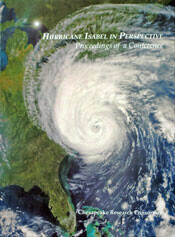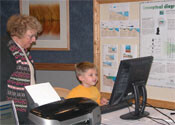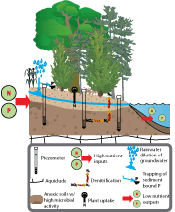Hurricane Isabel in Perspective Conference Proceedings
 In October, the Hurricane Isabel in Perspective: Proceedings of a Conference volume was released, documenting the proceedings of a conference convened 15-17 November, 2004. The Hurricane Isabel in Perspective conference was organized as a venue for the lessons learned from Hurricane Isabel, which visited the Chesapeake Bay region in September 2003. Planners, scientists, emergency responders, and academics alike agreed that the numerous lessons learned from Hurricane Isabel will greatly assist our society’s ability to prepare for, respond to, and recover from the next major storm event. The presentation of these lessons forms the contents of this proceedings volume.
In October, the Hurricane Isabel in Perspective: Proceedings of a Conference volume was released, documenting the proceedings of a conference convened 15-17 November, 2004. The Hurricane Isabel in Perspective conference was organized as a venue for the lessons learned from Hurricane Isabel, which visited the Chesapeake Bay region in September 2003. Planners, scientists, emergency responders, and academics alike agreed that the numerous lessons learned from Hurricane Isabel will greatly assist our society’s ability to prepare for, respond to, and recover from the next major storm event. The presentation of these lessons forms the contents of this proceedings volume.
Seagrass and Mangrove community interaction research initiatives
 Seagrass and mangrove communities often grow in close proximity. IAN staff have recently been involved in two efforts to help understand the linkages and interactions between these communities. Bill Dennison and Candy Feller chaired a special session at the recent Estuarine Research Federation (ERF) conference in Norfolk entitled “Interdisciplinary Approach to Research in Tropical Seagrass and Mangrove Ecosystems”. Mangrove and seagrass presentations were alternated to encourage engagement between the two fields. With funding from the Smithsonian Marine Science Network Colloquium, Tim Carruthers and Candy Feller organized a field workshop at the Smithsonian Tropical Research Institute in Bocas del Toro, Panama, following ERF. Bill Dennison as well as Giuseppe DiCarlo, Terry Jordan, and Ben Longstaff joined a total of 20 seagrass and mangrove scientists for the week long workshop. The workshop aims to produce a series of publications focused on linkages between seagrass and mangrove communities. From the ERF session as well as the Panama workshop, a synthesis paper on the current state of knowledge of these interactions in Caribbean habitats has been invited for publication in Estuaries.
Seagrass and mangrove communities often grow in close proximity. IAN staff have recently been involved in two efforts to help understand the linkages and interactions between these communities. Bill Dennison and Candy Feller chaired a special session at the recent Estuarine Research Federation (ERF) conference in Norfolk entitled “Interdisciplinary Approach to Research in Tropical Seagrass and Mangrove Ecosystems”. Mangrove and seagrass presentations were alternated to encourage engagement between the two fields. With funding from the Smithsonian Marine Science Network Colloquium, Tim Carruthers and Candy Feller organized a field workshop at the Smithsonian Tropical Research Institute in Bocas del Toro, Panama, following ERF. Bill Dennison as well as Giuseppe DiCarlo, Terry Jordan, and Ben Longstaff joined a total of 20 seagrass and mangrove scientists for the week long workshop. The workshop aims to produce a series of publications focused on linkages between seagrass and mangrove communities. From the ERF session as well as the Panama workshop, a synthesis paper on the current state of knowledge of these interactions in Caribbean habitats has been invited for publication in Estuaries.
IAN Symbol Libraries a big hit at the Horn Point Lab Open House
 On October 15, the UMCES Horn Point Lab (HPL) Open House was held, with over 700 adults and children exploring the eight science display areas in the Aquaculture and Restoration Ecology Lab building. A touch tank, oyster and fish hatchery tours, field work films, project posters, and sampling equipment provided interesting and interactive opportunities for the public to learn from faculty and students about the activities going on at the laboratory. At the IAN table, conceptual diagram posters were displayed and computers were available for anyone to try their hand at creating a Chesapeake Bay scene using the IAN Symbol Libraries. Young children loved playing with the symbols, while teenagers were excited to see how effective and useful this technique of science communication could be for school projects and reports, and adults considered the potential of conceptual diagrams for business or personal use.
On October 15, the UMCES Horn Point Lab (HPL) Open House was held, with over 700 adults and children exploring the eight science display areas in the Aquaculture and Restoration Ecology Lab building. A touch tank, oyster and fish hatchery tours, field work films, project posters, and sampling equipment provided interesting and interactive opportunities for the public to learn from faculty and students about the activities going on at the laboratory. At the IAN table, conceptual diagram posters were displayed and computers were available for anyone to try their hand at creating a Chesapeake Bay scene using the IAN Symbol Libraries. Young children loved playing with the symbols, while teenagers were excited to see how effective and useful this technique of science communication could be for school projects and reports, and adults considered the potential of conceptual diagrams for business or personal use.
IAN Symbols used in winning poster at MEES Colloquium
 The 2005 Marine Estuarine Environmental Sciences (MEES) graduate program colloquium was held at the Center of Marine Biotechnology in Baltimore on October 7-8, 2005 with a student poster session on the second day. Forty-three posters were judged by a panel of MEES faculty, and Adrienne Sutton of the UMCES Horn Point Lab received the “outstanding” award and a $500 stipend for her poster, describing her research on the impact of restored riparian buffers on nutrient inputs at the watershed scale. Employing IAN’s extensive symbol libraries and science communication techniques, along with some guidance from IAN’s Tim Carruthers, she created conceptual diagrams, illustrating the points of her study. Adrienne says she is “now officially an IAN convert” and enthusiastically encourages others to take advantage of the IAN resources.
The 2005 Marine Estuarine Environmental Sciences (MEES) graduate program colloquium was held at the Center of Marine Biotechnology in Baltimore on October 7-8, 2005 with a student poster session on the second day. Forty-three posters were judged by a panel of MEES faculty, and Adrienne Sutton of the UMCES Horn Point Lab received the “outstanding” award and a $500 stipend for her poster, describing her research on the impact of restored riparian buffers on nutrient inputs at the watershed scale. Employing IAN’s extensive symbol libraries and science communication techniques, along with some guidance from IAN’s Tim Carruthers, she created conceptual diagrams, illustrating the points of her study. Adrienne says she is “now officially an IAN convert” and enthusiastically encourages others to take advantage of the IAN resources.